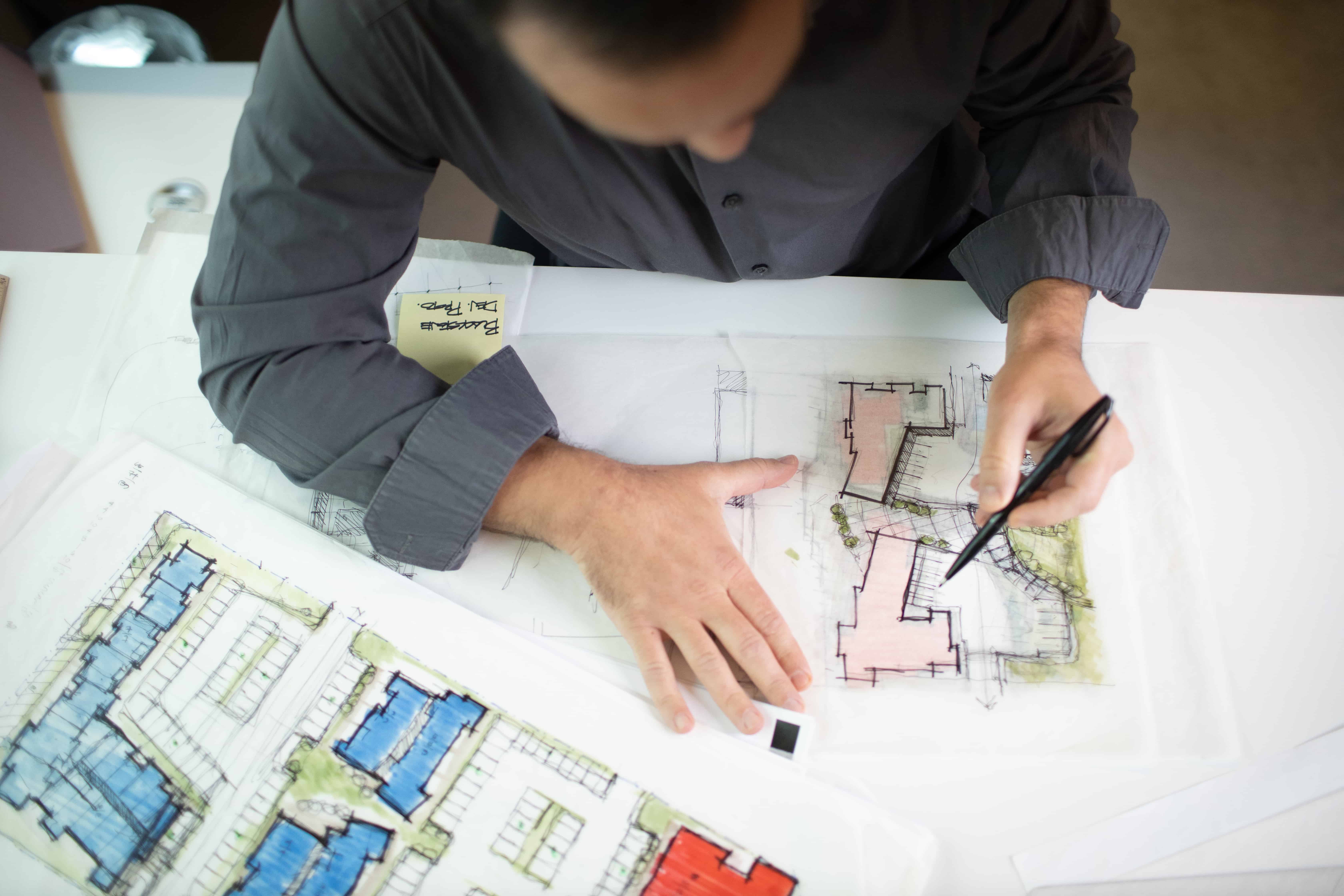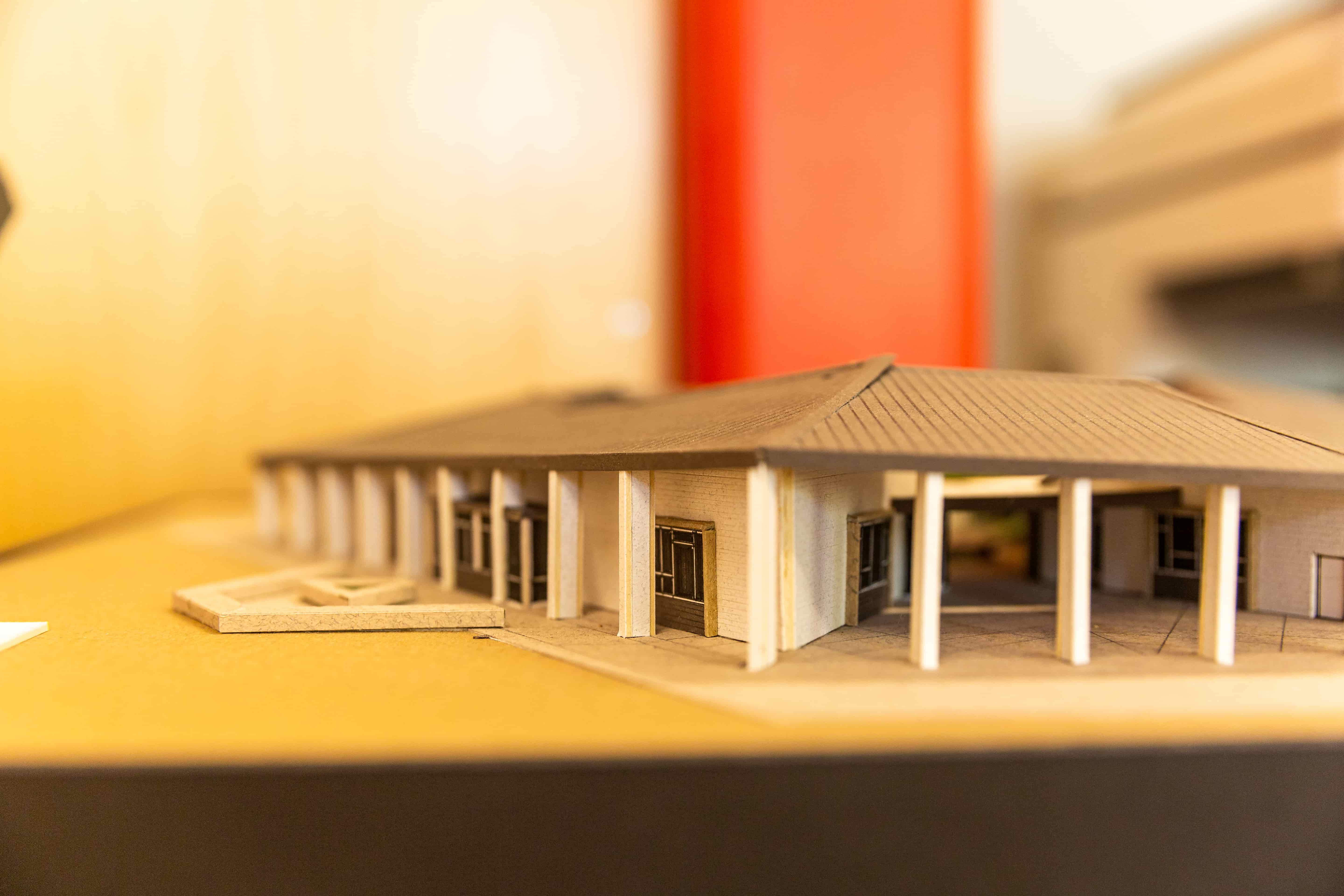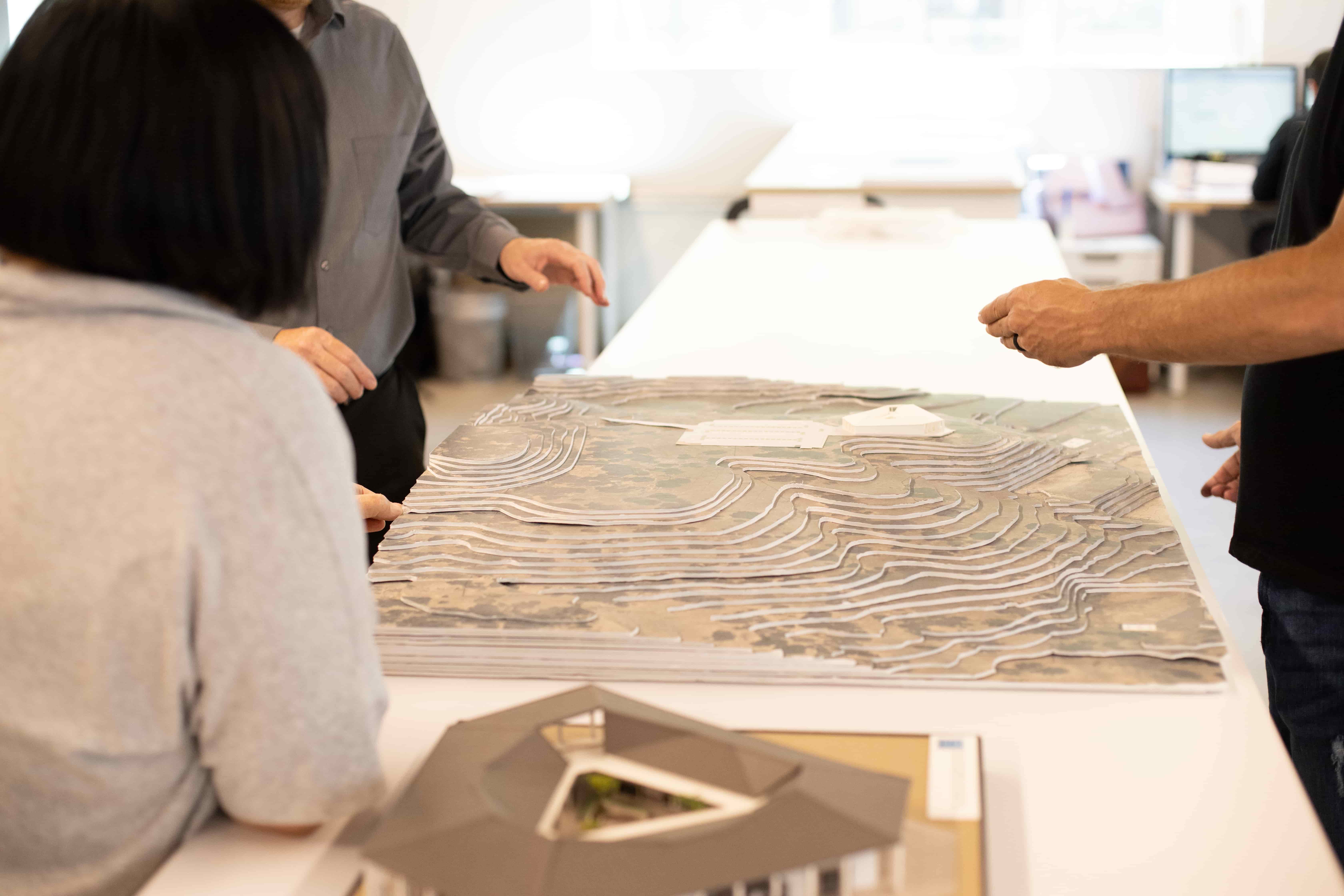What Does an Architect Do?

Author: Paul
When we hear someone bring up or talk about architects, they are often fascinated by architecture. It’s incredibly rewarding to imagine something that has never been built before, then deciding and directing what labor, materials, and equipment are necessary to complete the build.
We often hear things like, “Oh, I wanted to be an architect but wasn’t good at math,” or “I can’t draw a straight line.” However, these perceived roadblocks have very little to do with the day-to-day practice of architecture.

We like to think of a building as an artifact that memorializes the goals, values, and aspirations of those who designed and built it at a given point in time.
Architects, the professionals who design these artifacts, are sensitive interpreters of society’s conditions. They design buildings and spaces that are informed by the cultural norms of the day, the built environment that we inhabit, and how we live and organize our communities.
What Is an Architect?
Architects are trained and skilled professionals who design, plan, and often play key roles in the construction of buildings.
Having gone through a comprehensive process that includes higher education, apprenticeship, and state certification, architects:
- Are fine-tuned in the art and science of design
- Are professionally licensed
- Have experience in developing functional spaces
- Have a personal love for design
- Address building aesthetics, function, and safety through design work
What Are the Different Types of Architects?
There are two ways we can look at what types of architects there are depending on what we’re talking about: the technical definition, or the general understanding of what an architect is.
Types of Licensed Architects – Technical Definition
Technically and legally, the title of “architect” can only be used by a person licensed to practice architecture. Any unlicensed person can’t legally refer to themselves with any title containing “architecture,” “architect,” or “architectural.” Architects are charged with protecting the health, safety, and welfare of the public, which is regulated by the State.
Architects, firms, clients, and anyone who is involved in the architectural process consider the following roles when thinking of the different types of architects. Keep in mind that an architect may be involved in all three roles depending on the project!
- Design Architects – These architects focus on transforming a client’s vision and needs into a design.
- Production/Technical Architects – These architects review designs, polishing and translating them into drawings and documents that are used to construct the final products.
- Project Managers – These architects supervise the construction process, making sure communication about any changes or issues between architects, engineers, contractors, and the client progress smoothly.
Types of Designers in Architecture – Generalized Understanding
You may have heard an architect described as someone who designs buildings or functional spaces. This generalized definition of an architect includes licensed and unlicensed designers who specialize in specific types of design in the architectural process.
- Sustainable/LEED Architect – LEED-certified architects who specialize in sustainable architecture, including net-zero buildings, spaces that take advantage of alternative energy sources, and materials that are less harmful to the environment.
- Interior Designers – These designers often aren’t licensed architects, but they do to interior spaces what architects do to buildings—design the spaces to fulfill aesthetics, function, and safety requirements.
- Industrial Architects – These architects specialize in factories, storage areas, offices, and other buildings that are integral to industrious processes.
- Commercial Architects – These architects design multi-vendor shopping strips, hotels, and other buildings that are used for commercial or business purposes.
- Residential Architects – These architects design sprawling residential developments, or single, custom homes.
- Landscape Architect – Landscape architects have their own professional licensure separate from architecture. They design, develop, and maintain the landscapes around buildings or other structures, along with developments such as golf courses or public & private parks.
#LEED certified existing buildings in #California were associated with 50% less GHGs from water use, 48% less #GHGs from solid waste, and 5% less GHGs from transportation. pic.twitter.com/tqhSvTedF8
— USGBC Northern California (@usgbcncc) August 10, 2018
What Makes Architects Happy?
- Whether you’re an architect or not, being happy with your job and responsibilities is important to your personal and professional success. Here are a few things that make our architects and designers happy during the architectural process:
- A satisfied client
- Participating in the construction process
- A project built as designed
- People using the building you designed
- A great relationship with the construction team
- When the client, architect, and contractors leave as friends
What Does an Architect Do?
An architect’s job is more than just drawing building designs and calculating proportions. Architects are also more than what you see with their portrayal in the media, whether it’s building the identity of main character Ted Mosby in the hit TV rom-com, “How I Met Your Mother,” or being the intellectual missing link of a team navigating the dream metaverse in the movie, “Inception.”
Architects, like most other professionals, work hard to craft healthy relationships with those they serve. They build these relationships with current and prospective clients, developers, builders, sub-contractors, educators, government officials, non-profits, and others interested in creating a healthier society.
The job of an architect can best be described as transforming a client’s needs, feelings, and vision into a building that becomes a marker of identity. Read on for a breakdown on what an architect does.
Architects' Roles and Responsibilities
An architect serves three roles when it comes to designing a building for a client:
- Consult and design
- Create documentation
- Oversee construction
The specific tasks of an architect depend on the location and nature of the work. It also depends on the role an architect has in the design and build processes. However, architects have specific responsibilities when designing a building for a client:
- Gather information, data, goals, and constraints from the client and/or end-user
- Develop a conceptual design and schematic design based on the client’s needs and requests
- Refine the design concept and schematic design using sustainable methods and other building opportunities
- Develop construction documents for contractors to construct the building
- Oversee a team of architects, contractors, civil engineers, and the client during the construction phase
Check out our guides on the conceptual phase, design phase, and construction phase of the architectural process for more information on these responsibilities.
Along with these main responsibilities, as an architect you would also:
- Frequently communicate with clients to identify their needs to build
- Budget projects
- Protect the health, safety, and welfare of buildings’ future occupants
- Run small businesses and manage teams
- Help market their firms and secure new business
- Incorporate mechanical, electrical, plumbing, and other key components into designs
- Satisfy building code and zoning regulations
- Secure project approvals and permits from regulatory authorities
- Lobby at the local and state levels on matters that impact what and how architects build

What Architects Do: Large Firms, Small Firms, Independent Architects
Architecture is taught in the design studio environment at the university level, in which staff members collaborate often on projects—many architecture firms are structured around this environment, aiding in your journey from student to architect.
Architects’ individual tasks are different depending on what setting they are working in, and that also comes with different rewards. As an architect, you may want to consider choosing a setting that aligns with what is most comfortable for you.
Architects' Role in Large Firms
In a large firm with many architects, your role and responsibilities may be more specialized. An architect at a large firm is often more “I”-shaped, and can share in a level of prestige from projects with a national or global reach. This also means that architects may be less involved in the management aspect of an architect’s job.
Architects' Role in Small Firms
In smaller firms, such as Paul Halajian Architects, architects occupy more roles and may become architectural designers, drafters, and construction managers. Your role at a smaller agency would mean you would be more “T’-shaped, meaning that you would specialize in your specific role but would also have knowledge and use your experience in the other parts of the architectural process.
In smaller firms, the work produced tends to have a local impact, with an architect’s own community’s improvement becoming deeply rewarding.
Role of an Independent Architect
Ideally, independent architects with their own practice should have as much knowledge and experience in as many facets of the architectural process as possible. As an independent architect, you’ll receive valuable experience while being involved in every step, but it may also limit your ability to specialize in specific areas of architecture.
Architect Work Environment & Hours
Similar to how your role could vary, the size of your firm could change your work environment. Larger firms tend to be very structured and hierarchical, while smaller firms tend to be flatter and more open. Each size has its own benefits that work for different architects.
Regardless of the firm’s size, it takes time and passion to make great buildings, so that can occasionally mean working long hours and weekends. This could mean you’ll have to focus more on finding a good work-life balance. However, as an architect, you’ll find the rigor and camaraderie of working on a passionate design team to be very rewarding.
You can expect to spend time at:
- Your desk space in your firm
- Clients’ offices
- Planning offices of local governments
- Building construction sites
- Overseas at international conferences and meetings
Architects' Educational Requirements in California
Along with receiving your architecture license by taking the national ARE registration exam administered by the National Council of Architectural Registration Boards, California architects are expected to:
- Complete the Architecture Experience Program (AXP)
- Obtain a professional degree: a Master of Architecture (M.Arch) or a Bachelor of Architecture (B.Arch) through a 5-year program at an accredited institution
- Complete mandatory continuing education
Similar to their jobs, architects’ work environments differ depending on the situation. Larger firms tend to be very structured and hierarchical, while smaller firms tend to be flatter and more open.
Why Should I Become an Architect?
Before deciding to become an architect, consider the following questions.
- Do you care about doing work that impacts people?
- Do you strive to make things that will outlast you?
- Is having a positive impact on the world a key goal for you?
These are some of the key questions that should be addressed before starting your journey to become an architect. If you answered “yes,” then ask yourself these questions.
- Are you both imaginative and disciplined?
- Do you respect art and math?
If the answers to these questions are still “yes,” then you have the foundation to succeed in architecture!
Architects have a rare combination of creativity and disciplined thinking. Often, they are also intuitive, expressive, introspective, and innovative—but the most common trait among architects is having a passion for architecture.

Learning More About Architects
Did we answer your questions about what architects do? Follow us on Facebook and Instagram and head over to halajianarch.com to learn more about architects, what they do, and why architecture is important.
